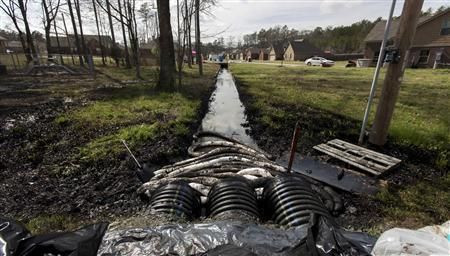Mayflower Oil Spill Effects: Dead Ducks, Residents Report Breathing Problems

An ExxonMobil pipeline rupture last week unleashed a flow of crude oil in central Arkansas, prompting the evacuation of 22 homes. With the fate of the controversial Keystone XL pipeline in limbo, the new spill in the city of Mayflower is a timely reminder of the environmental and health risks posed by fossil fuel accidents.
Oily ducks and other birds started to turn up days after the spill, prompting officials to warn people not to handle them. As of Saturday, 13 dead ducks, one dead nutria (a semiaquatic rodent that looks a bit like a beaver or muskrat) and three deceased turtles have been recovered. One Mayflower beekeeper reported finding some of her insects dead and covered in oil, according to local TV station KARK.
Mayflower lies near two state wildlife management areas -- Camp Robinson and Bell Slough, the latter of which is home to around 200 species of birds, according to one Arkansas birding site. A little more than two miles west of the town is the Arkansas River, which feeds into the Mississippi River.
ExxonMobil crews are already scooping up soil in the affected areas, and boom lines are being used to keep oil from spreading through nearby lakes and rivers. The company says it’s already captured around 12,000 barrels of oil and water.
Exxon, the U.S. Environmental Protection Agency, and state agencies are continuing to monitor the impact of the spill. Though many residents have reported a pervasive smell of oil, air quality in the spill area seems to be holding at relatively safe levels.
“Containment levels in the community continue to be below levels likely to cause health effects for the general population with the exception of the cleanup areas where the emergency responders are directly working,” the Arkansas Department of Environmental Quality said.
However, some residents are already complaining of breathing problems and sinus issues as of Monday.
"I haven't seen a lot of health authorities going into the neighborhoods and asking people directly, knocking on doors trying to find out well what are people experiencing in terms of their health," National Resources Defense Council communications associate Rocky Kistner told the news station KATV.
KATV reporter Justin Lewis documented several cases, including one of Mayflower resident Kirby Higgs.
"Bad sinus problems, you can [tell] by looking at my eyes," Higgs told KATV. "They're burning."
It’s still unclear what caused the rupture. The pipeline at issue is the Pegasus line, a 20-inch diameter pipeline that spans about 850 miles from Pakota, Ill. to the Texas Gulf Coast. The Pegasus pipeline was originally built in the late 1940s. Originally, the pipeline was built to transport thinner oil at a lower pressure. But in 2006, Exxon repurposed the Pegasus pipeline to transport diluted bitumen – crude oil similar to what the Keystone KL pipeline would carry -- and reversed the flow to carry the crude southward.
“A change in the direction of flow can affect the hydraulic and stress demands on the pipeline,” the U.S. Pipeline and Hazardous Materials Safety Administration said in a corrective order issued to ExxonMobil on April 2.
In magnitude, the Mayflower spill pales in comparison to the 2010 spill that followed the Deepwater Horizon Accident. Nearly three years after the BP oil spill that unleashed an estimated 4.9 million barrels into the Gulf of Mexico, experts are still struggling to capture the environmental impact. A National Wildlife Federation report released on April 2 suggests that the Gulf may have suffered ecosystem-wide effects, with organisms from plankton to sea turtles to bottlenose dolphins showing signs of contamination.
What the BP spill -- or the Mayflower spill -- hold in store for impacted areas in the long-term, however, is still uncertain.
© Copyright IBTimes 2024. All rights reserved.





















